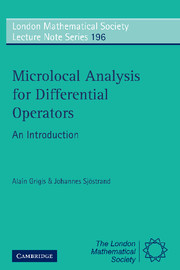Book contents
- Frontmatter
- Contents
- Introduction
- 1 Symbols and oscillatory integrals
- 2 The method of stationary phase
- 3 Pseudodifferential operators
- 4 Application to elliptic operators and L2 continuity
- 5 Local symplectic geometry I (Hamilton–Jacobi theory)
- 6 The strictly hyperbolic Cauchy problem — construction of a parametrix
- 7 The wavefront set (singular spectrum) of a distribution
- 8 Propagation of singularities for operators of real principle type
- 9 Local symplectic geometry II
- 10 Canonical transformations of pseudodifferential operators
- 11 Global theory of Fourier integral operators
- 12 Spectral theory for elliptic operators
- Bibliography
- Index of notations
- Index of terminology
Introduction
Published online by Cambridge University Press: 05 October 2013
- Frontmatter
- Contents
- Introduction
- 1 Symbols and oscillatory integrals
- 2 The method of stationary phase
- 3 Pseudodifferential operators
- 4 Application to elliptic operators and L2 continuity
- 5 Local symplectic geometry I (Hamilton–Jacobi theory)
- 6 The strictly hyperbolic Cauchy problem — construction of a parametrix
- 7 The wavefront set (singular spectrum) of a distribution
- 8 Propagation of singularities for operators of real principle type
- 9 Local symplectic geometry II
- 10 Canonical transformations of pseudodifferential operators
- 11 Global theory of Fourier integral operators
- 12 Spectral theory for elliptic operators
- Bibliography
- Index of notations
- Index of terminology
Summary
This book corresponds to a graduate course which has been taught many times at the universities Paris-Sud, Paris-Nord and Paris 7, and other places. The aim of this text is to give the foundation of what is nowadays called microlocal analysis in the C∞ framework, as it was created in the sixties and seventies by Kohn-Nirenberg, Maslov and Hörmander. Our presentation follows essentially the one given by Hörmander [Hö2]; as for the symplectic geometry, we have been inspired by the lecture notes of Duistermaat [D].
This subject is of growing importance, with a range of applications going beyond the original problems of linear partial differential equations. In particular the link with quantum mechanics is now firmly established, and there is a growing number of books covering more or less specialized parts of the theory. We believe that a short monograph concentrating on the basic principles could be of value, not only for the graduate student, but also for the mathematician who wants to get quickly into the subject and to understand its basic mechanisms. For this, the classical PDE framework seemed to us the most suitable one. The basic principles of microlocal analysis are essentially only two: integration by parts and the method of stationary phase. Compared with the article [HÖ2] and many of the other presentations, we have insisted even more on the stationary phase method, which appears already in the development of the theory of pseudodifferential operators and also (as in Melin-Sjöstrand [MS]) in the proof of the equivalence of phase functions in the global theory of Fourier integral operators.
Information
- Type
- Chapter
- Information
- Microlocal Analysis for Differential OperatorsAn Introduction, pp. 1 - 4Publisher: Cambridge University PressPrint publication year: 1994
Accessibility standard: Unknown
Why this information is here
This section outlines the accessibility features of this content - including support for screen readers, full keyboard navigation and high-contrast display options. This may not be relevant for you.Accessibility Information
- 1
- Cited by
